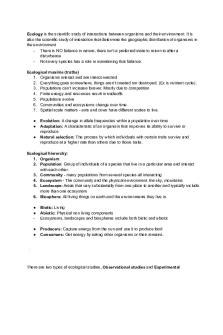Lecture 1 PDF

| Title | Lecture 1 |
|---|---|
| Course | Computer Architecture |
| Institution | Stony Brook University |
| Pages | 6 |
| File Size | 538.1 KB |
| File Type | |
| Total Downloads | 14 |
| Total Views | 142 |
Summary
Lecture 1 Notes...
Description
Computer Architecture ● Instruction Set Architecture + Machine Organization (Microarchitecture)
Properties of a good abstraction ● ● ● ●
Lasts through many generations (portability) Used in many different ways (generality) Provides convenient functionality to higher levels Permits an efficient implementation at lower levels
Instruction Set Architecture ● ● ● ● ● ●
Organization of Programmable Storage Data Types & Data Structures: Encodings & Representations Instruction Formats Instruction (or Operation Code) Set Modes of addressing and Accessing Data Items and Instructions Exceptional Conditions
Example: MIPS
Organization (Microarchitecture) ● Capabilities and Performance Characteristics of Principal Functional Units ○ Ex: Registers, Shifters, Logic Units ● Ways in which these components are interconnected ● Information flows between components ● Logic and means by which such information flow is controlled ● Choreography of FUs to realize the ISA ● Register Transfer Level (RTL) Description
All computers have 5 components
What is Computer Architecture ● Old definition was instruction set architecture (ISA) ○ Other aspects of computer design is implementation. ● Our view is computer architecture >> ISA ● Architect’s job is much more than instruction set design. Technical hurdles today is more challenging that in instruction set design ● In a broad definition, computer architecture is the designs of the abstraction layers to maximize performance within constraints (cost,power, and availability) that allow us to implement information processing applications efficiently using available manufacturing technologies
● In its broad definition, computer architecture is the designs of the abstraction layers to maximize performance within constraints (e.g cost,power and availability) that allows us to implement information processing applications efficiently using available manufacturing technologies
Ideas in Computer Architecture 1. 2. 3. 4. 5. 6.
Levels of Representation Technology Trends Principle of Locality/Memory Hierarchy Parallelism Performance Measurement Dependability via Redundancy
Idea 1: Levels of Representation
Idea 3: Principle of Locality/Memory Hierarchy
Idea 4: Parallelism
Idea 5: Performance Measurement and Improvement ● Allows direct comparisons of architectures and quantification of improvements ○ Most common measures are time to finish (latency) and rate of execution (throughput) ● Match application and hardware to exploit: ○ Locality, parallelism, special hardware features
Idea 6: Dependability via Redundancy ● Applies to everything from datacenters to storage to memory ○ Redundant data centers so that can lose 1 datacenter but internet service stays online ○ Redundant disks so that can lose 1 disk but not lose data (Redundant Arrays of Independent Disks/RAID) ○ Redundant memory bits of so that can lose 1 bit but no data (Error Correcting Code/ECC Memory)...
Similar Free PDFs

Lecture-1 - Lecture notes 1
- 6 Pages

Lecture notes, lecture 1
- 9 Pages

Lecture notes, lecture 1
- 4 Pages

Lecture-1-notes - lecture
- 1 Pages

Lecture notes- Lecture 1
- 20 Pages

Lecture notes, lecture 1
- 4 Pages

Lecture notes, lecture 1
- 9 Pages

Lecture 1
- 3 Pages

Lecture 1
- 30 Pages

Lecture 1
- 6 Pages

Lecture 1
- 9 Pages

Lecture 1
- 76 Pages

Lecture 1
- 5 Pages

Lecture 1
- 32 Pages

Lecture 1 Unit 1
- 2 Pages
Popular Institutions
- Tinajero National High School - Annex
- Politeknik Caltex Riau
- Yokohama City University
- SGT University
- University of Al-Qadisiyah
- Divine Word College of Vigan
- Techniek College Rotterdam
- Universidade de Santiago
- Universiti Teknologi MARA Cawangan Johor Kampus Pasir Gudang
- Poltekkes Kemenkes Yogyakarta
- Baguio City National High School
- Colegio san marcos
- preparatoria uno
- Centro de Bachillerato Tecnológico Industrial y de Servicios No. 107
- Dalian Maritime University
- Quang Trung Secondary School
- Colegio Tecnológico en Informática
- Corporación Regional de Educación Superior
- Grupo CEDVA
- Dar Al Uloom University
- Centro de Estudios Preuniversitarios de la Universidad Nacional de Ingeniería
- 上智大学
- Aakash International School, Nuna Majara
- San Felipe Neri Catholic School
- Kang Chiao International School - New Taipei City
- Misamis Occidental National High School
- Institución Educativa Escuela Normal Juan Ladrilleros
- Kolehiyo ng Pantukan
- Batanes State College
- Instituto Continental
- Sekolah Menengah Kejuruan Kesehatan Kaltara (Tarakan)
- Colegio de La Inmaculada Concepcion - Cebu
